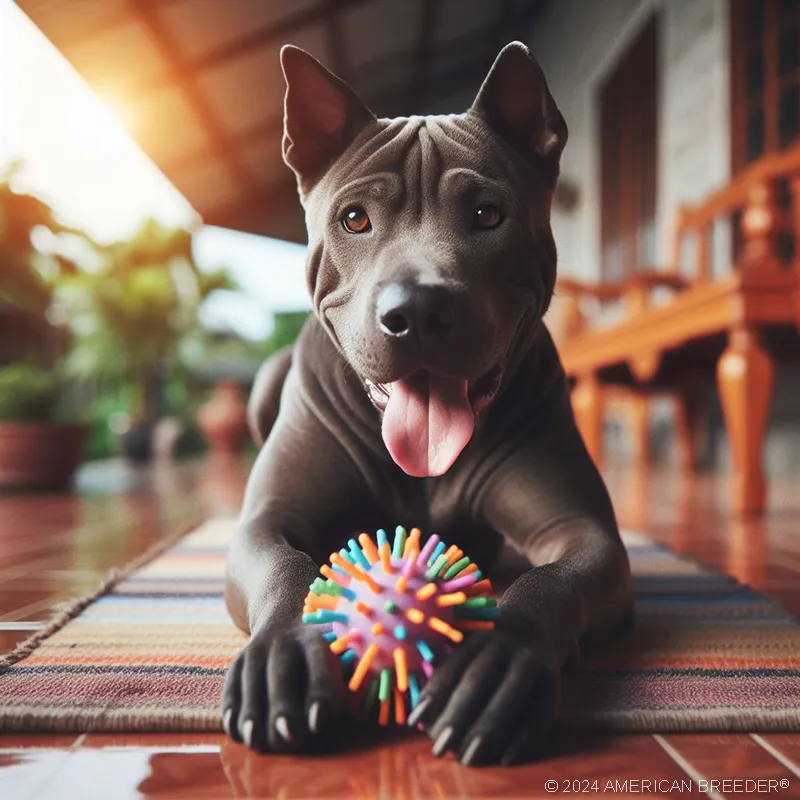Thai Ridgeback Allure: Loyalty, Grace, and Boundless Adventure
Welcome to the Thai Ridgeback Dog – a breed that seamlessly blends ancient history with modern companionship. In this guide, we'll delve into every aspect of this remarkable canine, from their origins and distinctive appearance to their temperament, health, training, and more. We're committed to providing you with a wealth of knowledge that will help you understand, care for, and enjoy the company of a Thai Ridgeback Dog.
 Introducing the Thai Ridgeback Dog
Introducing the Thai Ridgeback Dog
Meet the Thai Ridgeback Dog – a breed with a lineage that dates back centuries, hailing from the rich tapestry of Thailand's history. Renowned for their distinctive ridge of hair along their back, these dogs captivate the heart and imagination with their unique appearance and steadfast loyalty. From their early roles as versatile working dogs to their current status as cherished family members, the Thai Ridgeback has carved a niche in the lives of dog enthusiasts around the world.
Origin and Development
To truly understand the Thai Ridgeback Dog, one must journey to their origins in Thailand. Bred to be skilled hunters, guardians, and companions, these dogs were valued for their adaptability and versatility. The name "Ridgeback" pays homage to their most striking feature – a ridge of hair that grows against the grain along their back. This distinguishing characteristic sets them apart from other breeds and serves as a testament to their unique genetic heritage.
Purpose and Versatility
The Thai Ridgeback Dog is a living embodiment of versatility. From their roles as adept hunters in rugged terrains to their responsibilities as vigilant guardians of homes and livestock, these dogs seamlessly integrated into various aspects of human life. As companions, their loyalty and protective instincts shine brightly, creating unbreakable bonds with their families. This breed's multifaceted nature continues to make them cherished members of households and communities worldwide.
Appearance and Distinctive Features
The Thai Ridgeback Dog's appearance is a study in grace and strength. Their sleek coat comes in a range of colors including blue, black, red, and fawn, showcasing their regal elegance. However, it's the unique ridge of hair that demands attention – a feature that varies in appearance from dog to dog, much like a fingerprint. Almond-shaped eyes radiate intelligence and curiosity, while their erect triangular ears capture every nuance of their environment. The overall impression is one of harmonious balance between beauty and power.
Beyond their physical characteristics, the Thai Ridgeback Dog's unique ridged back has a fascinating history. The ridge is a result of a natural mutation that occurred in the breed's early development. This genetic trait has been passed down through generations and is one of the defining features of the breed. While the ridge is a notable physical attribute, it's essential to remember that each Thai Ridgeback is an individual, and their personality and behavior are equally important aspects of their identity.
Temperament and Behavior
 Behind the Thai Ridgeback Dog's regal exterior lies a temperament characterized by loyalty, independence, and protectiveness. While their loyalty to their family is unwavering, they may be reserved around strangers due to their protective instincts. Early and ongoing socialization plays a crucial role in shaping their behavior positively. Their independence demands patient, consistent, and positive reinforcement-based training to build a strong and respectful relationship.
Behind the Thai Ridgeback Dog's regal exterior lies a temperament characterized by loyalty, independence, and protectiveness. While their loyalty to their family is unwavering, they may be reserved around strangers due to their protective instincts. Early and ongoing socialization plays a crucial role in shaping their behavior positively. Their independence demands patient, consistent, and positive reinforcement-based training to build a strong and respectful relationship.
The Thai Ridgeback Dog's protectiveness and vigilance make them excellent watchdogs. Their keen senses and natural instincts make them alert to any changes in their environment, often alerting their owners to potential threats. While this trait can be advantageous, it's important to provide proper training to ensure that their protective behavior doesn't lead to aggression or excessive territoriality. Positive socialization from an early age can help them discern between genuine threats and harmless situations, contributing to a well-balanced and confident companion.
Energy Levels and Lifestyle
Understanding the Thai Ridgeback Dog's energy levels is key to a harmonious companionship. Their history as active hunters and guardians translates to a need for regular physical and mental stimulation. Engaging in activities such as brisk walks, interactive play, and training sessions is essential to their well-being. Providing opportunities for them to channel their energy fosters a deep bond and helps prevent behavioral issues that may arise from boredom or excess energy.
It's important to note that the Thai Ridgeback Dog's energy levels may vary based on individual personality and age. While they are generally an active breed, puppies and young adults tend to have higher energy levels that gradually stabilize as they mature. As your Thai Ridgeback transitions from puppyhood to adulthood, their exercise routine should be adjusted accordingly to accommodate their changing energy needs. Engaging in a variety of physical and mental activities throughout their life ensures their happiness and helps prevent them from becoming restless or bored.
Socialization and Relationships
Socialization is the cornerstone of a well-adjusted Thai Ridgeback Dog. Early and positive exposure to different people, animals, and environments molds their behavior and ensures they grow into confident companions. While they tend to get along well with children and other pets when introduced correctly, their protective nature may lead to wariness of strangers. Proper socialization cultivates a dog that is not only well-behaved but also adaptable to various situations.
Socialization not only influences how Thai Ridgeback Dogs interact with their environment but also plays a significant role in their mental and emotional well-being. Positive experiences during socialization lay the foundation for a well-rounded dog who feels comfortable in various settings. In addition to introducing them to different people and animals, consider exposing your Thai Ridgeback to novel sounds, sights, and experiences. This broadens their understanding of the world and helps them approach new situations with confidence and curiosity.
Caring for a Thai Ridgeback Dog involves more than meets the eye. Despite their short coat, regular brushing is essential to distribute natural oils and manage shedding. Bathing should be done as needed, typically every few months, to maintain coat health. Regular nail trimming, ear cleaning, and dental care are integral to their overall well-being. Grooming sessions serve as bonding opportunities and reinforce trust between owners and their furry companions. Beyond the physical aspect, grooming sessions also provide a chance to check for any signs of skin issues, infections, or injuries. Maintaining good hygiene practices ensures that your Thai Ridgeback remains comfortable, healthy, and looking their best.
It's important to note that the Thai Ridgeback Dog's coat care needs may vary depending on their specific coat type. While their short coat requires minimal grooming compared to longer-haired breeds, the presence of the ridge on their back can lead to unique grooming considerations. Gently brushing the ridge with a soft bristle brush helps prevent matting and keeps the hair aligned, contributing to the characteristic ridge appearance. Additionally, regular grooming sessions provide an opportunity for you to bond with your dog and establish a positive association with the grooming process.
Health and Wellness
The health and well-being of your Thai Ridgeback Dog are paramount. Like all breeds, they may be prone to certain health conditions, such as hip dysplasia, dermoid sinus, and hypothyroidism. Regular veterinary check-ups are essential to monitor their overall health and catch any potential issues early. As responsible owners, you can take steps to promote their well-being by providing a balanced diet, regular exercise, and mental stimulation. Engaging in preventive measures, such as vaccinations, flea and tick control, and regular dental care, ensures a long and vibrant life for your furry companion.
While it's important to stay informed about common health issues that may affect the Thai Ridgeback Dog, it's equally vital to remember that not all individuals will experience the same health challenges. Regular veterinary visits, proper nutrition, and a healthy lifestyle can greatly influence your dog's overall health and well-being. Pay attention to their individual needs and consult with your veterinarian to develop a personalized healthcare plan that addresses their specific requirements.
Training a Thai Ridgeback Dog is a dynamic journey that fosters a strong bond between you and your pet. Their intelligent and independent nature requires a patient and positive approach to training. Using reward-based methods, you can teach them basic commands, manners, and advanced skills. Mental enrichment activities, such as puzzle toys, interactive games, and scent work, engage their keen senses and prevent boredom. Consistent and engaging training sessions contribute to a well-behaved and mentally stimulated companion.
Considering the Thai Ridgeback Dog's history as a versatile working breed, incorporating activities that tap into their natural instincts can provide them with a fulfilling and purposeful lifestyle. Engaging in activities like nose work, agility, or even basic obedience competitions can channel their energy and stimulate their minds. These activities not only strengthen the bond between you and your dog but also showcase their intelligence and abilities in various settings.
Living with a Thai Ridgeback Dog
Bringing a Thai Ridgeback Dog into your home is a commitment that reaps countless rewards. While they are adaptable to various living environments, their active nature requires a household that can provide ample opportunities for exercise and mental stimulation. Secure fencing is essential, as their hunting instincts may lead them to explore beyond boundaries. Their protective nature makes them excellent watchdogs, but proper socialization and training are crucial to ensure they interact appropriately with guests and other pets.
Considering the Thai Ridgeback Dog's history as a guardian and protector, it's important to address their protective instincts when introducing them to new people and situations. Early socialization to various environments, experiences, and people will help them discern between genuine threats and everyday interactions. Furthermore, providing them with ample opportunities for physical and mental exercise, as well as regular companionship, helps prevent separation anxiety and destructive behaviors that may arise from boredom or loneliness.
 The Thai Ridgeback Dog Community
The Thai Ridgeback Dog Community
The Thai Ridgeback Dog community is a diverse and passionate group of enthusiasts who share a common love for this remarkable breed. Connecting with fellow owners through breed clubs, online forums, and social media platforms provides a wealth of knowledge, support, and camaraderie. Participating in dog-related events, such as conformation shows, agility trials, and canine sports, offers opportunities for your Thai Ridgeback to showcase their talents and strengthen your bond with them.
Engaging with the Thai Ridgeback Dog community not only enriches your own experience but also contributes to the collective knowledge and well-being of the breed. Sharing insights, experiences, and tips with fellow owners fosters a sense of belonging and offers a platform to learn from others' journeys. Attending breed-specific events and activities not only highlights the breed's unique attributes but also provides opportunities for your Thai Ridgeback to shine in various competitions and exhibitions.
A Companion for a Lifetime
The Thai Ridgeback Dog is more than just a breed – they're loyal companions, guardians, and family members. From their ancient origins to their modern roles, these dogs have retained their distinctive traits, capturing the hearts of those fortunate enough to share their lives. As you embark on this journey with your Thai Ridgeback, remember that you're welcoming a companion who embodies history, loyalty, and unwavering love. By understanding their origins, embracing their unique qualities, and nurturing their well-being, you're ensuring a rewarding and enriching partnership that will span a lifetime.
With your Thai Ridgeback Dog by your side, you're not just caring for a pet; you're becoming part of a legacy that reaches back through time and connects you to a breed with a storied past and a promising future. As you navigate the joys and challenges of dog ownership, let your journey be guided by a profound respect for this remarkable breed's heritage and an unwavering commitment to providing the best possible life for your beloved Thai Ridgeback.
Thai Ridgeback Dog Quick Reference Guide
 Breed Background:
Breed Background:
Origin: Thailand | Breed Purpose: Hunting, Guarding, Companionship | AKC Class: Foundation Stock Service | Year Recognized by AKC: Not AKC recognized
Appearance:
Size: Medium | Weight: Males: 35-55 lbs, Females: 25-45 lbs | Coat Type: Short, sleek | Colors & Patterns: Blue, Black, Red, Fawn, Brindle | Distinctive Features: Ridge of hair along back, "fishhook" tail
Temperament:
Energy Level: 4/5 | Loyalty: 5/5 | Friendliness to Pets: 3/5 | Friendliness to Strangers: 2/5 | Trainability: 3/5 | Playfulness: 4/5 | Frequent Barker: 3/5 | Chase Instincts: 4/5 | Sense of Smell: 3/5 | Drive to Hunt: 4/5
Health & Care:
Health Issues: Hip Dysplasia, Dermoid Sinus | Lifespan: 10-12 years | Grooming Difficulty: Low | Exercise Needs: High
Socialization:
Interaction with Children: Good with supervision | Interaction with Pets: Variable, early socialization important | Interaction with Strangers: Reserved | Elderly Compatibility: May be suitable | Ease of Training: Moderate
Suitable Living Arrangements:
Apartment: Not recommended | House: Yes | Rural Area: Yes | Yard Size Requirements: Medium to Large yard
Training & Obedience:
Trainability: 3/5 | Intelligence: 4/5 | Obedience: 3/5 | Problem-Solving: 3/5 | Easily Stimulated: 4/5 | Focus Level: 3/5 | Easily Distracted: 3/5
Financial Planning:
Typical Price Range: $800 - $1,500 | Initial Expenses: Puppy essentials, training classes | Ongoing Annual Expenses: Food, grooming, veterinary care
Breeding:
Reproductive Maturity: Around 8-12 months | Litter Frequency: 1-2 litters per year | Litter Size: 6-10 puppies | Stud Cost: Varies | Breeding Challenges: Dermoid sinus screening, careful selection for health
Did You Enjoy this Article? Share it and Help Us Spread the Word!
If you found this article helpful, we'd appreciate it if you could share it with your friends or link to it from your website, blog, or group! You can also use the convenient social share tabs on the left side of the screen to instantly share this page to your social media feed. For more ways to support and promote the American Breeder Community, visit our Share & Promote Together page for social media posts and memes you can copy and share. Your support means the world to us!
Disclaimer: The information provided in this article is for general informational purposes only and does not constitute legal, medical, financial, or professional advice. While we strive for accuracy, we make no representations or warranties regarding the completeness, accuracy, reliability, or suitability of the information. Please consult with a professional before making decisions based on the content provided. American Breeder Inc. assumes no responsibility for any errors or omissions or for the results obtained from the use of this information.


